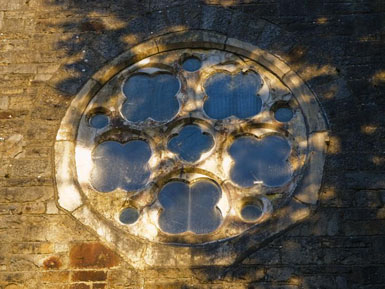This church was built c. 1860 by the local landlord, Charles Henry Tottenham, as part of a planned village. The church comprised of a three-bay nave, single-bay vestry and entrance porch. The roof is natural slate and has a projecting eave with exposed rafters and supporting gutters on rafter brackets. The church is constructed in coursed limestone with tooled sandstone blocks to corners, window dressings, door surrounds, and corbels.
Construction
The church is constructed for the most part from a cavity wall construction, which is unusual for the period. This construction was innovative and has helped to preserve the fabric of the building, keeping the interior dryer than many buildings of this type and age. The base of the walls externally are constructed with a battered plinth giving the building a sense of being more firmly rooted to the ground, and this thickening of the walls strengthens the base of the wall.
Rose Window
This rose window on the south east gable is in sandstone with quatrefoil tracery. The glazing is clear glass, and has possibly replaced the original stained glass. This window is a distinctive feature which elevates the design element of the church as artistically and technically significant.

Vestry Door
This doorway is formed in cut and dressed sandstone blocks with chamfered corners. The fanlight, also constructed in dressed sandstone is a twin trefoil window, and distinctive for its use as a fanlight. The dressings are fine and well executed, including plinth blocks.
Main External Door
This door consists of an ogee-headed door surround, with latticed lancets, and dressed sandstone surround, all fine and well executed.
Paired latticed lancet windows
These windows are cast iron with latticed pattern glazing of clear glass, with opening sashes set in a dressed sandstone surround. The fine detailing on the cast iron glazing bars give the windows a fine proportion of glass to solid. The glass seems to have been replaced in some windows.
Chimney to Vestry
This chimney is constructed in fine cut and dressed sandstone, with a circular capping stone.
Back
|
|
Consecration of Kiltyclogher new Church - 1867
This church so much-needed was on Wednesday the 24th inst. solemnly set apart “from all profane and a common uses” and dedicated for ever to their worship of Almighty God nor did the severity of the day take from the interest of the ceremony. At half-past 12 o'clock the Bishop of Kilmore, Elphin, and Ardagh was met at the west door by the Revs. W. Scott, J. Hamilton, J. Herne, Griffith, Hudson, Wilkins, Egan, Jemison, Lauder, Smullen, Tate, Flurry, A. L. Tottenham Esq. the churchwardens and others. The usual petition was presented to the Bishop by Mr Tottenham praying him to consecrate the church, after which the Bishop followed by the clergy posts he did up the aisle reading the 24th Psalm. The Bishop then taking his place at the north end of the communion table, the consecration prayer was (in the unavoidable absence of the Register) read by Mr Versecoyle, the Bishop’s son, this being done their Bishop offered up with great solemnity prayer is suited for the location. The morning service was read by the Rev. W. Scott, the lessons were read by the Rev. Mr Wilkins, being 1. Kings viii chap. And part of Heb. X chap. After the litany part of the 122nd Psalm was sung. The Church being crowded the singing led by Mr Cummins, and in which saw many joined, seemed to inspire feelings of reverent awe. The Bishop then read their communion service assisted by the Rev. J. Hamilton. After that Nicene Creed the 100 Psalm was sung with increasing effect by nearly all the assembly. The Bishop then preached from Heb.x1. 4. Space will not allow us to give extracts which we fain would do, but this we will say, that the breathless attention in which the falling of a pin would almost be audible, where you young and order hung on the words as they fell from the lips of the preacher, if this be proof of an effective sermon, then have we reason to hope, that did not then fall by the wayside.
After the sermon collection was made to gained in paying off a small debt still due on stables built for the accommodation of the total, the collection amounted to nearly £10 leaving only five pounds now due. The benediction being pronounced, the Bishop, clergy, Ladies, Gentlemen and others too numerous to notice individually, were invited to the market house, where lunch was prepared by Mr Tottenham, and so ample was the provision made, that after all there present had partaken heartily, the inhabitants of the village and neighbourhood were brought in and treated abundantly to the good thing is provided for the interesting occasion. – Communicated. Impartial Reporter August 1st, 1867.
Back
|
|

